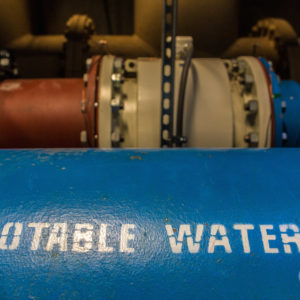The Stream, October 1, 2020: Hot, Dry Conditions Lead To Emergency Water Release in Rio Grande
The Global Rundown
Emergency water is released into the Rio Grande amid a long period of drought. Some communities in South Africa are experiencing Day Zero conditions. A new study finds global coastal flooding disproportionately affects people living on river deltas. Great Lakes data shows a new annual record for drownings in Lake Michigan. Mexico City’s poorest suffer from a lack of access to clean water.
“Honestly, [the government] doesn’t know the situation that we live in. They say wash your hands, but they’ve got water in the center of the city. We don’t out here.” – Victoria Arias Lopez, a resident of the San Gregorio neighborhood in the Xochimilco district of Mexico City. Amid the coronavirus pandemic, there are some places in San Gregorio with no running water for handwashing. Water is delivered to the neighborhood every 15 days, but Arias Lopez said it’s too dirty to drink and it only lasts her family about three days. With such limited supplies, they rarely wash their hands. Their story is common among Mexico City’s poorest areas, where 20 percent of the population doesn’t have access to water every day. CNN
In context: Five Things You Need to Know About WASH and Covid-19
Latest WaterNews from Circle of Blue
Explainer: Who regulates U.S. drinking water, and how? – Federal, state and local governments all have a hand in protecting public water systems and private wells from contamination. This story was co-published with Ensia, a solutions-focused nonprofit media outlet reporting on our changing planet.
HotSpots H2O: Conflict over U.S.-Mexico Water Treaty Escalates at Farmers Take La Boquilla Dam – Tensions between Mexico and the United States over water intensified month as months of Mexican farmers seized control of La Boquilla dam in protest over mandatory water releases.
By The Numbers
2 The number of municipalities in South Africa that have been unable to supply water to their residents without imported water tanks. Nelson Mandela Bay residents started rationing water the beginning of September and last week, the water in the Ebenezer Dam in the Groot Letaba River fell to 12.4 percent. Dam levels in the Limpopo province, where the Ebenezer Dam is located, continue to drop, according the Department of Water and Sanitation. Hot weather conditions have attributed to the declining water levels in the province, and a spokesperson for the Department of Water and Sanitation said the department is actively working on long-term solutions for the water shortage problem. IOL
89 percent The percentage of people living on river deltas in the same latitudinal zone as most tropical cyclone activity, according to a new study. Warmer oceans and more moisture in the atmosphere are strengthening tropical storms—and putting residents in mostly poorer nations at greater risk. The researchers responsible for the study calculated that 31 million of the people exposed to tropical cyclone flooding globally live on deltas, 25 million of which are in developing or the least developed nations. They conclude that because coastal flooding will continue to be a problem, the focus of coastal flooding needs to be reframed to include impacts on deltaic communities. Nature Communications
Science, Studies, and Reports
The number of drownings in Lake Michigan have reached a record high as new data shows 53 people have died by drowning so far this year. The data is gathered by the Great Lakes Surf Rescue Project, a nonprofit that educate the public about water safety, research and training in order to end drownings in the Great Lakes. Dave Benjamin, the organization’s executive director of project management, said the rise could be blamed to the pandemic, which forced the closure of pools across Michigan. However, he and his team say this is more likely “the new normal” for the Great Lakes unless states invest in more trained lifeguards, updated equipment and water safety education. Detroit Free Press
On the Radar
The Bureau of Reclamation, the Interstate Stream Commission and the Middle Rio Grande Conservancy District plan to release emergency water into the Rio Grande flowing through Albuquerque, New Mexico to keep it from drying up this fall. Forecasts by federal climatologists suggest hot and dry conditions that prompted the emergency water release will continue across much of the West over the next three months. These predictions have prompted concerns that this year’s releases will leave little water in storage. Without this extra water, however, officials said much of the Rio Grande would have been dry by April and would have stayed dry for most of the past summer. AP
Jane is a Communications Associate for Circle of Blue. She writes The Stream and has covered domestic and international water issues for Circle of Blue. She is a recent graduate of Grand Valley State University, where she studied Multimedia Journalism and Women, Gender and Sexuality Studies. During her time at Grand Valley, she was the host of the Community Service Learning Center podcast Be the Change. Currently based in Grand Rapids, Michigan, Jane enjoys listening to music, reading and spending time outdoors.






Leave a Reply
Want to join the discussion?Feel free to contribute!